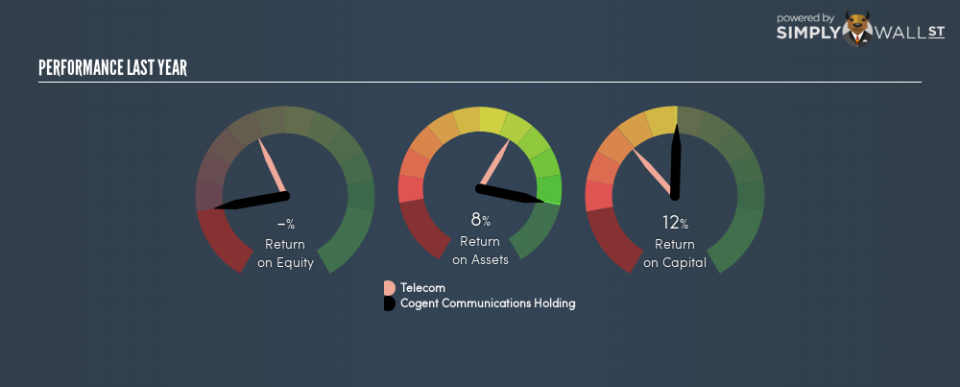Cogent Communications Holdings, Inc. (NASDAQ:CCOI) Earns Among The Best Returns In Its Industry

Want to participate in a short research study? Help shape the future of investing tools and you could win a $250 gift card!
Today we’ll look at Cogent Communications Holdings, Inc. (NASDAQ:CCOI) and reflect on its potential as an investment. To be precise, we’ll consider its Return On Capital Employed (ROCE), as that will inform our view of the quality of the business.
Firstly, we’ll go over how we calculate ROCE. Next, we’ll compare it to others in its industry. And finally, we’ll look at how its current liabilities are impacting its ROCE.
Return On Capital Employed (ROCE): What is it?
ROCE is a measure of a company’s yearly pre-tax profit (its return), relative to the capital employed in the business. Generally speaking a higher ROCE is better. In brief, it is a useful tool, but it is not without drawbacks. Author Edwin Whiting says to be careful when comparing the ROCE of different businesses, since ‘No two businesses are exactly alike.’
How Do You Calculate Return On Capital Employed?
Analysts use this formula to calculate return on capital employed:
Return on Capital Employed = Earnings Before Interest and Tax (EBIT) ÷ (Total Assets – Current Liabilities)
Or for Cogent Communications Holdings:
0.12 = US$72m ÷ (US$757m – US$72m) (Based on the trailing twelve months to September 2018.)
Therefore, Cogent Communications Holdings has an ROCE of 12%.
View our latest analysis for Cogent Communications Holdings
Is Cogent Communications Holdings’s ROCE Good?
When making comparisons between similar businesses, investors may find ROCE useful. Cogent Communications Holdings’s ROCE appears to be substantially greater than the 6.0% average in the Telecom industry. We consider this a positive sign, because it suggests it uses capital more efficiently than similar companies. Separate from Cogent Communications Holdings’s performance relative to its industry, its ROCE in absolute terms looks satisfactory, and it may be worth researching in more depth.
Our data shows that Cogent Communications Holdings currently has an ROCE of 12%, compared to its ROCE of 7.0% 3 years ago. This makes us think the business might be improving.
Remember that this metric is backwards looking – it shows what has happened in the past, and does not accurately predict the future. ROCE can be deceptive for cyclical businesses, as returns can look incredible in boom times, and terribly low in downturns. ROCE is only a point-in-time measure. What happens in the future is pretty important for investors, so we have prepared a free report on analyst forecasts for Cogent Communications Holdings.
How Cogent Communications Holdings’s Current Liabilities Impact Its ROCE
Liabilities, such as supplier bills and bank overdrafts, are referred to as current liabilities if they need to be paid within 12 months. Due to the way ROCE is calculated, a high level of current liabilities makes a company look as though it has less capital employed, and thus can (sometimes unfairly) boost the ROCE. To check the impact of this, we calculate if a company has high current liabilities relative to its total assets.
Cogent Communications Holdings has total assets of US$757m and current liabilities of US$72m. Therefore its current liabilities are equivalent to approximately 9.5% of its total assets. In addition to low current liabilities (making a negligible impact on ROCE), Cogent Communications Holdings earns a sound return on capital employed.
The Bottom Line On Cogent Communications Holdings’s ROCE
If it is able to keep this up, Cogent Communications Holdings could be attractive. Of course you might be able to find a better stock than Cogent Communications Holdings. So you may wish to see this free collection of other companies that have grown earnings strongly.
If you like to buy stocks alongside management, then you might just love this free list of companies. (Hint: insiders have been buying them).
To help readers see past the short term volatility of the financial market, we aim to bring you a long-term focused research analysis purely driven by fundamental data. Note that our analysis does not factor in the latest price-sensitive company announcements.
The author is an independent contributor and at the time of publication had no position in the stocks mentioned. For errors that warrant correction please contact the editor at editorial-team@simplywallst.com.

 Yahoo Movies
Yahoo Movies 

